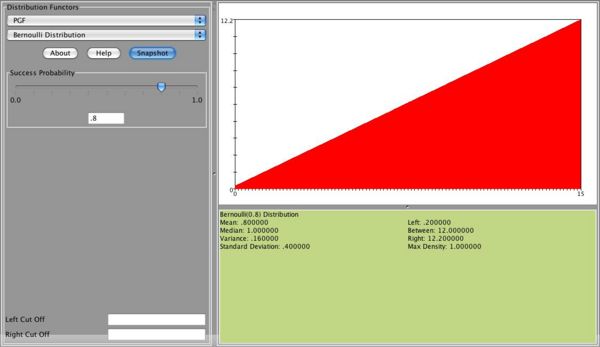SOCR EduMaterials Activities Binomial PGF
From Socr
This is an activity to explore the Probability Generating Functions for the Bernoulli, Binomial, Geometric and Negative-Binomial Distributions.
- Description: You can access the applets for the above distributions at http://www.socr.ucla.edu/htmls/SOCR_DistributionFunctors.html .
- Exercise 1: Use SOCR to graph the PGF's and print the following distributions and answer the questions below. Also, comment on the shape of each one of these distributions:
- a.

- b.

- c.

- d.

- a.
Below you can see a snapshot of the PGF of the distribution of 

Do you notice any similarities between the graphs of these PGF's between any of these distributions?
- Exercise 2: Use SOCR to graph and print the PGF of the distribution of a geometric random variable with p = 0.1,p = 0.8. What is the shape of this function? What happens when p is large? What happens when p is small?
- Exercise 3: You learned in class about the properties of PGF's If X1,...Xn are iid. and
 then
then ![P_{y}(t) = {[P_{X_1}(t)]}^n](/socr/uploads/math/4/4/7/44715cd09714f0e09436cdd22aa5b660.png) .
.
- a. Show that the PGF of the sum of n independent Bernoulli Trials with success probability p is the same as the PGF of the Binomial Distribution using the corollary above.
- b. Show that the PGF of the sum of n independent Geometric Random Variables with success probability p is the same as the MGF of the Negative-Binomial Distribution using the corollary above.
- c. How does this relate to Exercise 1? Does having the same PGF mean they are distributed the same?
- Exercise 4: Suppose that X has a pgf Px(t) = (1 − p) + pt and let Y = aX + b. What is Py(t) ?
See also
- SOCR Home page: http://www.socr.ucla.edu
Translate this page:
